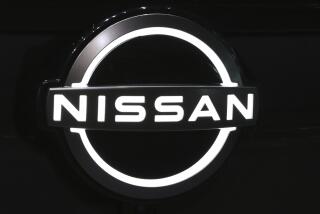Safety Pillows
- Share via
Auto manufacturers will be required to provide more head protection in coming years, as changes to federal requirements are phased in. Some manufacturers are already providing inflatable head protection devices as standard or optional equipment. They absorb the energy of a side impact and help prevent front and rear passengers from being partially thrown out of side windows.
How They Work
Inflatable head protection bags work in conjunction with side-impact bags. They’re designed to protect front and rear occupants seated next to windows from hitting their heads on windows or roof pillars.
A. Volvo’s “inflatable curtain” is stored inside head liner, drops down when deployed and inflates in about 25 milliseconds.
B. BMW’s Inflatable Tubular Structure is attached to roof and windshield pillar, stays inflated for about six seconds.
1. Air bag system is stored in trim of roof rail. Inflater is stored behind dashboard.
2. Bag is activated by signals from impact sensors fitted in the body side.
3. Channels in bag are filled with gas and inflate in 1/25,000th of a second. Bag stays inflated for six seconds after deploying.
Who Has Them
Head protection air bag status for selected car makers:
BMW: Standard in all sedans
Ford: All models, 1999 or 2000
Mercedes-Benz: Early 1999
Toyota: In some models in 1999
Volkswagen: Currently testing
Volvo: Standard on 1999 S80
What the Standard Says
New additions to the Federal Motor Vehicle Safety Standard 201 require manufacturers to provide extra head protection, either with padding or an inflatable bag. There will be a five-year phase-in schedule:
*--*
For model year starting %of vehicles Sept. 1, 1998 10 Sept. 1, 1999 25 Sept. 1, 2000 40 Sept. 1, 2001 70 Sept. 1, 2002 1000
*--*
Inflatable curtain can absorb as much as 75% of the energy the head exerts when it is thrown to the side.
Head Injuries, Fatalities
In recent years, about 2,400 occupants of light vehicles have been killed and 60,000 injured annually in crashes in which heads struck pillars, side rails, headers and other upper interior components. The National Highway Traffic Safety Administration estimates that the newhead protection rule will save up to 1,200 lives a year.
Nonfatal Injuries
Front-seat occupants in side impacts, yearly average from 1993-95 sampling data
*--*
Crash type Multiple vehicles total All 92,600 190,700 283,300 Side-impact 23,300 69,800 93,100 Side-impact with head injury from relevant contacts inside vehicle* 2,00 11,300 13,00 Side-impact with head injury from contacts outside vehicle** 400 800 1,200
*--*
Sources: Insurance Institute for Highway Safety, National Highway Traffic Safety Administration, BMW, Volvo Researched by JULIE SHEER/Los Angeles Times
*A-pillars, B-pillars, side window/frames or roof rails
**Exterior of own vehicle, struck vehicle, struck object or ground






